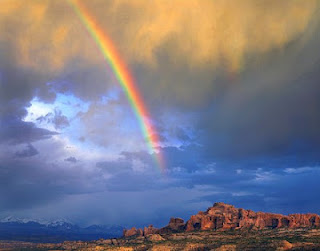It was a warm and sunny afternoon at Twin Rocks Trading Post.
Outside the temperature hovered in the mid-nineties, and we had the
Kokopelli doors pulled shut with the refrigeration blowing. Danny and I
were in the southeast corner of the store, recording videos for our weekly e-mailer, when I saw an antique cowboy walk past the plate glass windows.
He was moving briskly in the direction of the entrance, so I wrapped up
my interpretation of Peggy Black's modified ceremonial basket, motioned Danny
to cut the tape and sat back to see what the heat waves might guide inside.
Danny shut down the camera and we began discussing a new approach to
Internet marketing and how to expand our e-mail list.
 |
| Ceremonial Baskets |
The old gentleman pushed his way through the heavy doors and, as the
refrigerated air-cooled him, sighed in relief. I noticed he was small in
stature, but bore himself with confidence; his demeanor indicated
self-assurance. Perched on top of his head was a well worn and heavily
weathered straw hat that looked like it belonged right where it sat. Most
likely in his seventies, he was wiry and spry. His brown eyes shown
bright with intelligence, and it appeared he noticed every detail. The
old man's face was a dark walnut color, deeply etched and weathered, like many
of the Dine' who spend their time outdoors in this harsh environment. He
displayed a bright pink scarf about his neck, which contrasted greatly with the
rest of his attire. I suspected it was a statement about his feisty, fearless
attitude. Despite the heat, he wore a worn, but clean, long sleeve Levi's
shirt and Wrangler jeans bunched at the hips, knees and ankles. Around
his bony waste he had a wide, scuffed brown belt with a nondescript brass
buckle. Well-traveled and heavily scuffed black boots with once white,
now discolored, stitching and pointed toes covered his small but adequate feet.
At this point Danny noticed how the man was dressed and burst out
with, "Oh, a cowboy!" Our Internet administrator is rather
spontaneous, so we never quite know what he will do or say. Luckily the
man did not take offense, and forgave us our faux pas. To myself I thought,
"That is not just any cowboy, that is a Navajo cowboy." I may
have watched too many John Wayne movies as a kid, because the juxtaposition of
the words cowboy and Indian have always seemed strange and out of character to
me. Yet here was a clear example of just how well they worked
together. It has always been of interest to me how good the Navajo are at
assimilating. They adopt what they find good and useful and discard the
rest. No need to get caught-up in the negative, just move on.
Cowboy hats, boots, scarves, jeans and country music all survived the
cut, pretense did not. Our visiting Indian-cowboy friend began his tour
of the trading post while Danny and I resumed our conversation.
Before long the old-timer discovered Priscilla, our long-term
associate, floor manager and friend, and discovered that she too, spoke the
language of "The People". They were soon caught-up in a
conversation about ceremonial baskets. At that point I began wondering
whether the guy was a medicine man. If so, he was someone I did not know.
His air of confidence and that jaunty scarf made me wonder. The man
had selected three baskets and was locked in serious negotiations with
Priscilla. Many years ago she convinced us we should allow a substantial
discount to Native people who use ceremonial baskets for cultural purposes.
Craig, Steve and I agreed, and gave Priscilla liberty to do so. About
that time the telephone rang, so I hustled over to answer it.
As I spoke into the receiver, I noticed the man kept pointing and
waving me over. I in turn gestured to Priscilla, and said, "She's
the one you want to ask." I hung up the phone and Priscilla turned
to me and said, "He want's to speak with the boss." I looked at
the holy man and said, "You are speaking with the boss; Priscilla is in
charge around here." "That's what I told him", she said,
"but he doesn't believe me."
It turns out the guy was indeed a medicine man from Kayenta, Arizona,
and he wanted to deal with no one but the head honcho. The man looked us
over carefully, as if searching for a clue, then sighed in resignation and
reached for his billfold.
Pulling a credit card from his wallet, the man handed it to
Priscilla for processing. Since I am used to seeing elderly Navajo people
paying only in cash, I laughed out loud at the sight of plastic in his hand,
saying, "Since when do medicine men pay with credit cards? You
probably have a cell phone as well." The Indian/cowboy/medicine man
reached into the front pocket of his baggy jeans, produced his telephone, and
in perfect English said, "This is the modern age you know?" We
all laughed, and he headed out with his baskets. The medicine man reached
the Kokopelli doors and placed his hand on the knob. Turning back, he
asked; "Is she really the boss?" "This is the modern
age", I replied. "Good Point!" he said and continued on
his way.
With warm regards,
Barry, Steve, Priscilla and Danny; The Team

Barry Simpson likes
|
Great New Items! This week's selection of Native American art!
Our TnT's purchased new treasures! Check out Traders in Training!
Enjoy artwork from our many collector friends in Living with the Art!
Enjoy artwork from our many collector friends in Living with the Art!




